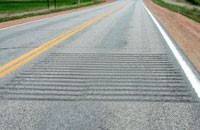Horizontal Displacement: Transverse Rumble Strips
Rumble strips are grooves placed in the roadway surface that transmit sound and vibration to alert drivers to changing conditions.

Rumble strips are grooves placed in the roadway surface that transmit sound and vibration to alert drivers to changing conditions.
To reduce run-off-road (ROR) crashes, rumble strips are typically placed longitudinal to the roadway surface on the shoulder or edge of pavement to alert drivers that they are leaving the roadway.
Rumble strips have also been placed perpendicular to the direction of traffic and used to alert drivers of a change in upcoming conditions.
Rumble strips have been used in advance of rural stop signs and prior to curves. In Iowa, transverse rumble strips are sometimes used on the approach to stop signs on rural roads.
Advantages
- Does not adversely affect emergency response services
- Does not interfere with vehicle operation
Disadvantages
- Noisy
- May be a hazard to motorcyclists and bicyclists
- Drainage can cause water or ice to pond in the strips
- Vehicles may swerve around them to avoid and, consequently, should be used with caution on high-volume roads (Fontaine et al. 2000) or placed across the entire width of the road.
Effectiveness
The Crash Modification Factors Clearinghouse provides the crash modification factors (CMFs) when installing transverse rumble strips as a traffic-calming device in urban and suburban areas.
CMFs for transverse rumble strip installation
| Crash Severity | CMF |
|---|---|
| Serious or minor injury | 0.64 |
| All | 0.66 |
Appropriateness
Rumble strips are used frequently in Iowa in advance of stop signs on rural roadways. Please note that their use in applications other than advance of stop signs is strongly discouraged by the Iowa Department of Transportation (Iowa DOT).
Cost
- Moderate costs
- Typically a standard bid item for the DOT and public agencies
Reference
Fontaine, Michael, Paul Carlson, and Gene Hawkins. Evaluation of Traffic Control Devices for Rural High-Speed Maintenance Work Zones: Second Year Activities and Final Recommendations. Report FHWA/TX-01/1879-2. Texas Transportation Institute, 2000.
